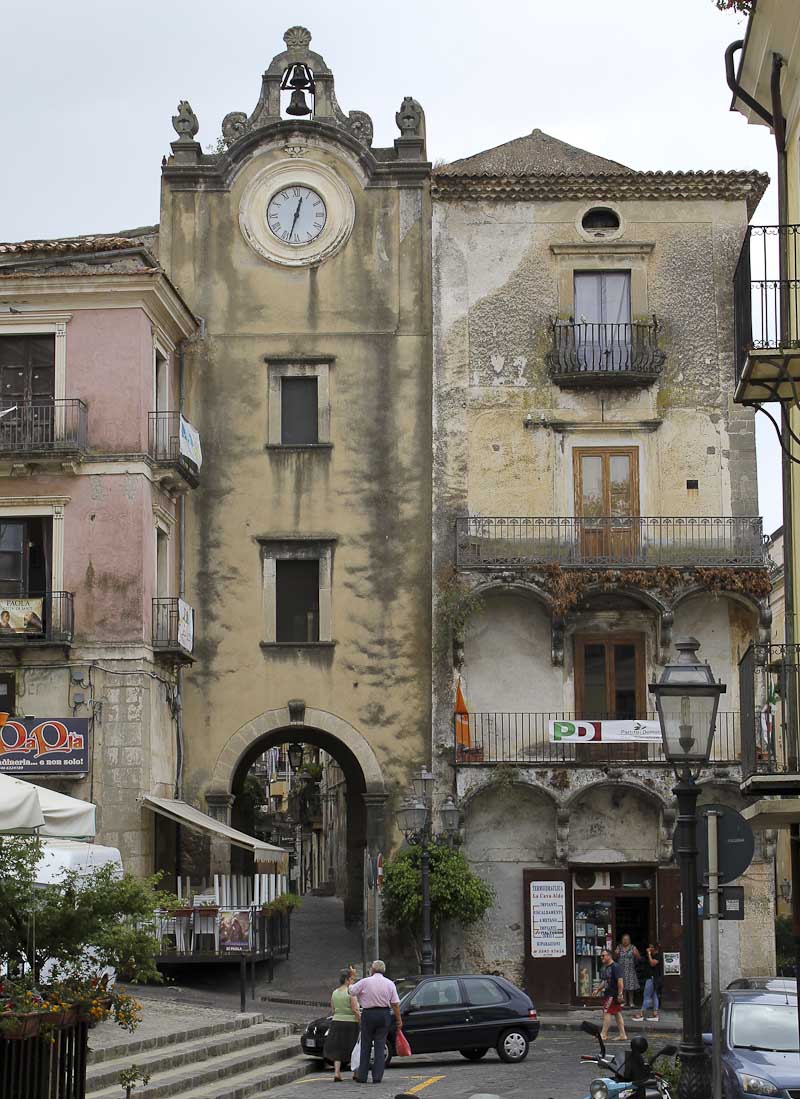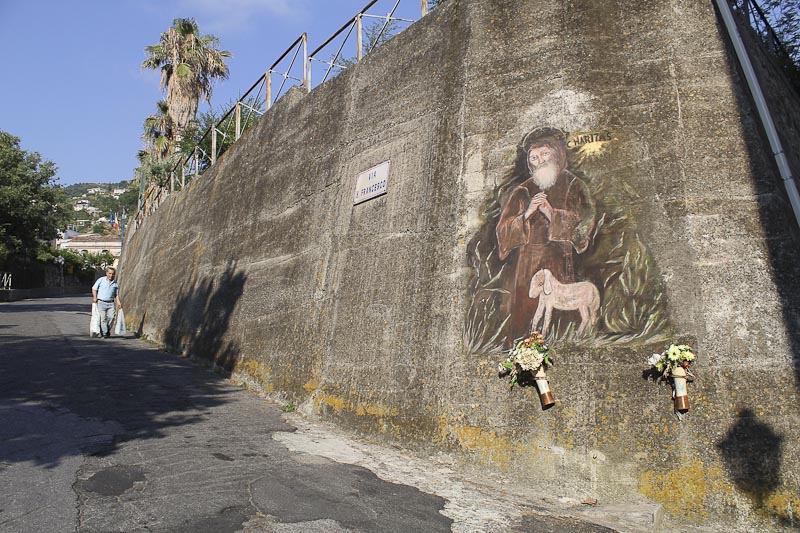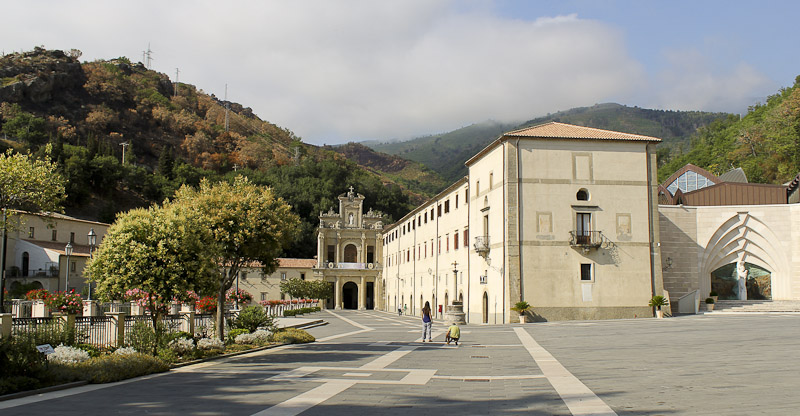Paola and the patron saint of Calabria
We went to Paola hoping to discover a rough Diamante, but all we found were trains, the patron saint of Calabria and a touring Calabrian fitness pageant.
The distance from Cosenza to Paola is only about 30 km, but it’s a winding road crossing the Calabrian Apennines and climate belts. We left Cosenza on a hot summer day, but clouds descended on Eremo di Santa Maria di Monte Persano leaving a dense fog and light drizzle between the tunnels, and although it cleared, when we reached Paola, the weather remained a little overcast and misty. We checked into Hotel Sant’Agostino and went out to explore the town.

The clocktower and a fountain mark the centre of Paola in Calabria
A town with a theme
Paola has around 15.000 inhabitants, who seem to have left the houses in the oldest part of town in a sorry state of disrepair in favour of more modern accommodation on the outskirts. However, there is a small centre when you reach Corso Garibaldi. We passed the monumental 17th century fountain called Fontana dei Sette Canali, which – like every other wall in Paola – is decorated with mostly dark, religious paintings of an old man with a white beard and a brown cloak. This was clearly a town with a theme, as we should have known if we had bothered to consult wikipedia or any old guidebook beforehand.
The solemn atmosphere lightened up on Piazza del Popolo, where there are several cafés, a combined salumeria, enoteca and restaurant, a church, a clocktower, a gate and another fountain known as Fontana dei Pisciarieddi. Hoping to see the coast and perhaps a beach we continued down Corso Roma, but railway tracks blocked the way to the coast and we didn’t find it worthwhile to look for a crossing.

Murals of San Francesco are everywhere in the historic centre of Paola
Getting to know San Francesco da Paola
Going back through the gate to the centro storico we were greeted by the statue of a man in a cloak carrying a staff and book of rules. From the iconographic attributes Calabrians and devout catholics might recognize him as San Francesco da Paola, but even without this insight we began to realise that apart from being and important junction, Paola is first and foremost a pilgrim site dedicated to the region’s patron saint who was born and lived in this area.
We spent the rest of the day exploring the narrow alleys and frescos of San Francesco in Paola’s centro storico, and after dark we came across a fitness pageant, where scantily clad men and women flexed their muscles for a limited audience. These travelling shows are a regular part of summer entertainment in many smallish south Italian towns.
The next morning we climbed up Via dei Miracoli to the Sanctuary of San Francesco di Paola. It is said that Calabrians have travelled the path between the old basilica, the new church and the cloistered monastery on the hill, but this day there were only a handful of other visitors along with a few resident monks, nuns and priests. The enormous parking lot was more or less deserted and business in the stalls selling religious souvenirs was slow bordering non-existent.

Walking up Via dei Miracoli towards the sanctuary
Miracles and waterfalls
Still the sanctuary turned out to be absolutely wonderful. It is built on the site, where San Franscesco di Paola was born in 1416. His parents were very religious and at the age of 13 he entered the friary, and undertook a pilgrimage to Assisi and Rome. Upon his return he chose to live as a hermit in a cave on his father’s grounds. He was later joined by a few followers and a chapel was built to accommodate the new order. By 1454 their numbers had grown and a large monastery and church was built.
The monastery complex is quite large with a courtyard garden, confession rooms and shrines. The surrounding area is especially enchanting with a small river, a waterfall, several caves and lush green – or in some places burned – vegetation as the place of origin for multiple miracles, myths and legends.

The monastery complex is quite large with a nunnery, a friary, two churches, several caves and a huge parklike area.
We learned the story of San Francesco’s favourite lamb Martinello, who followed him around wherever he went. During the construction of the church, some workers stole and ate the lamb, throwing fleece and bones into a lime kiln. When San Francesco found out what had happened, he went to the mouth of the furnace and shouted out for his pet, and immediately the lamb came back to life and jumped out of the flames.
Another legend claims that the saint made the stream in the garden flow with the touch of his hand and it still demonstrates its miraculous nature by always maintaining the same water level, no matter how you try to drain it. Visitors to the sanctuary use the ‘Cucchiarella’ spoon to sample some of the holy water and take it home with them.

The holy stream with constant water levels.
Protection from evil
From a small bridge known as the Deveíl’s Bridge people spit in the water below as a sign of respect for San Francesco. The story goes that when the saint contemplated building this bridge to facilitate the passage from one bank of the Isca river to the other, the devil appeared to him and offered to do the job in a single night in exchange for the soul of a traveler crossing the bridge. The saint accepted the proposal, but the next day when the devil shows up to collect his due, San Francesco lets a dog pass and invites the devil to take the animal’s soul. The trick makes the devil so furious he strikes out and leaves a print of his hand on the parapet wall.
You can also visit the sacred Grotta della Penitenza, where the saint supposedly remained enclosed for five years in contemplation and silence. And walk the narrow corridor to the Antico Romitorio, where the followers of San Francesco retired to pray. Here you can rest your head on a stone which has been touched by the saint and endowed with the power to cure any ailment.
In a wall near the new church a bomb from the second world war is displayed. It was aimed at Mussolini’s right hand man and secretary of the National Fascist Party, Carlo Scorza, but it fell into the stream by the monastery, where most of Paola’s inhabitants were hiding. At the behest of the saint, they say, it never detonated.
Paola may not be a typical south Italian seaside town, but it is rich in suggestive scenes, sacred places and mystic legends that have formed Calabria through centuries.



Leave a Reply
Want to join the discussion?Feel free to contribute!